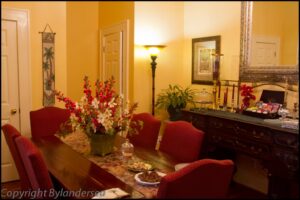
A Hotel Review
In colonial America, hostesses set out a fresh pineapple, a prized and valuable commodity, when visitors joined them. Over the years, the pineapple came to symbolize hospitality. Today we recognize all sorts of symbols such as the Nike swoosh meaning Just Do It or the green and white Starbucks cup of coffee. To me, a palm tree seems to say oasis: a respite from the sun, a place to fall asleep and a place to nourish our bodies. Certainly palm trees have provided coconuts to sustain the lives of many.
So, it is no surprise that the Green Palm Inn in Savannah, Georgia uses the palm tree as a symbol, or that the Inn offers the finest shelter or lodgings and scrumptious breakfasts and snacks around. It’s a true oasis.

The Green Palm Inn is owned by Diane and Gary Crews, but let’s gives Diane credit; she runs the place because Gary’s job often takes him away. As Innkeeper, Diane welcomes guests like family, sits down with them and introduces her southern city. Diane is a prized pineapple; she is hospitality personified. She’ll provide you will a cool drink, share her knowledge of history, and whisper insider tips, like the best tour guides, shuttle services, taxi drivers and restaurants..
I stayed in the Green Palm’s elegant Sable Palm Suite which could easily be a honeymoon haven. The gorgeous carved four-poster king-size bed makes a bold statement and commands your attention. You need a step stool to climb onto the elevated bed. There’s a bounty of pillows and high thread count linens to caress your skin with the softest touch.

Talk about romance, this suite has two fireplaces; one near the bed and the other in the bathroom. I also enjoyed the large open seating area with a settee, chair and antique wardrobe. But, you’ve got a modern small refrigerator in the corner and coffee machine.
Diane bakes extraordinary breakfast selections, a meal that will keep you going as you walk around Savannah’s streets, gardens and squares. The sensuous city drips with Spanish moss hanging from live oak trees, many over a hundred years old. Fountains are everywhere and provide a cool touch, even on a hot day.
More than likely you will return to the Green Palm in the late afternoon and find refreshments- freshly baked cookies or sweets, perhaps cheese and crackers, lemonade and wine. You can sit and chat with the other guests in the parlor or take your goblet up to your room for some quiet time.
The Green Palm Inn is cozy with just four rooms and also quiet. It’s just steps from Green Square (how appropriate is that) but actually named for Revolutionary War General Nathanael Greene and sits about four blocks from the riverfront. Should you choose to walk to this touristy area instead of the historic downtown, you are ideally situated.
The rates are remarkable low for a top of the line Bed and Breakfast and once you stay, you will return and likely tell others. Just be sure to book your room well in advance because the reputation of this oasis in Savannah is spreading

For information on The Green Palm Inn please visit:

For information about Savannah: www.VisitSavannah.com












